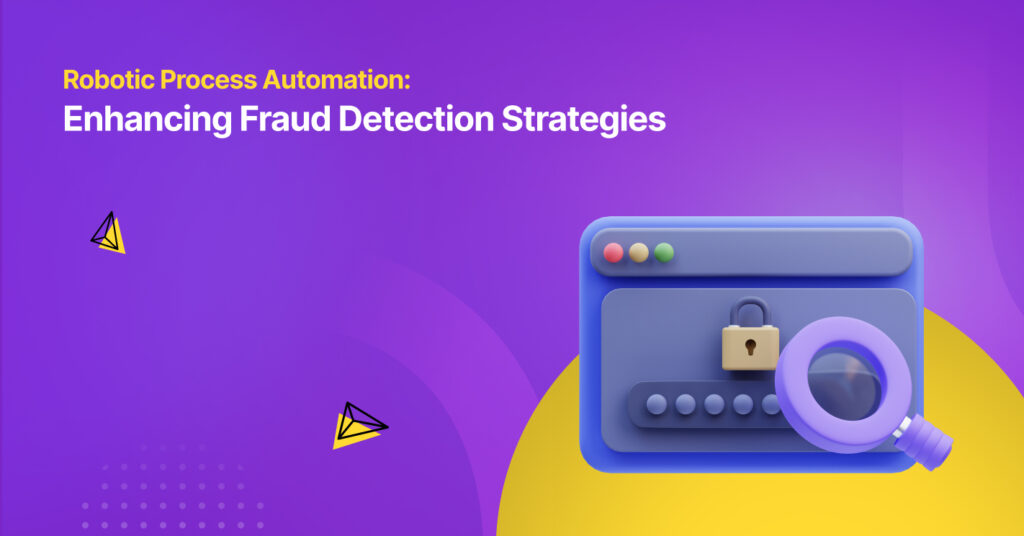Fraud detection has become a critical priority for businesses operating in high-transaction environments, such as banking, e-commerce, healthcare, and government sectors. As transaction complexity increases, so does the sophistication of fraudulent activities.
Robotic Process Automation (RPA) emerges as a transformative technology to detect and prevent fraud with unprecedented efficiency and accuracy. This article will explore how RPA revolutionises fraud detection, particularly in banking and other high-risk industries, while providing actionable strategies for implementation.
Exploring the Use of RPA in Fraud Detection
Utilises software “bots”, RPA automates repetitive tasks like data validation, anomaly detection, and alert management. In fraud detection, these bots can quickly process large datasets, monitor transactions, and flag suspicious activities for further review.
As a result of RPA integration, fraud detection has evolved from labour-intensive manual processes to AI-enhanced automated systems. RPA bridges scalability gaps, delivering faster responses to threats. This evolution addresses the limitations of traditional methods and provides the flexibility to adapt to emerging fraud patterns.
The Mechanics of RPA in Identifying and Preventing Fraud
RPA in fraud detection operates through a streamlined workflow. It begins with data collection, where bots gather and consolidate information from sources like transaction logs and customer records. This data is then analysed during the anomaly monitoring phase, using predefined rules or AI models to identify suspicious patterns, such as sudden spending spikes or mismatched details.
When a potential fraud is detected, RPA triggers alerts, escalating cases for human review. This division of labour allows bots to handle repetitive tasks efficiently, enabling fraud analysts to focus on complex investigations.
Integrating RPA with AI and Large Language Models (LLMs) takes detection to the next level. AI enhances pattern recognition and predictive analytics, while LLMs analyse unstructured data like emails or messages to uncover subtle fraud indicators. This combination improves accuracy, reduces false positives, and ensures legitimate transactions proceed smoothly, making RPA an indispensable tool for fraud prevention.
Strategies for Implementing RPA in Fraud Detection
- Conduct an Initial System Assessment and Identify Key Automation Opportunities
The first step in implementing RPA for fraud detection involves conducting a thorough assessment of existing processes. This evaluation helps identify tasks that are repetitive, time-consuming, and prone to human error —such as data validation, transaction monitoring, and report generation. These tasks are ideal candidates for automation, as RPA can handle them more efficiently, accurately, and consistently than manual efforts.
For example, RPA bots can validate transaction data across multiple systems, ensuring compliance with regulatory requirements and internal policies. Similarly, they can continuously monitor transactions for anomalies, reducing delays in fraud detection. By automating these routine tasks, fraud analysts can focus on complex cases that require human judgment, such as evaluating nuanced fraud patterns or addressing escalated incidents. This strategic redistribution of work not only improves operational efficiency but also enhances the overall effectiveness of fraud detection teams.
- Ensure Compliance and Data Security
Incorporating RPA into fraud detection strategies requires strict adherence to compliance and data security standards. Financial institutions and other high-risk industries operate within stringent regulatory frameworks, such as GDPR or PCI DSS, which demand robust protections for sensitive data. Therefore, RPA solutions must be designed and implemented with these requirements in mind.
Encryption is a critical feature, ensuring that data handled by RPA bots is protected both in transit and at rest. Role-based access controls are equally essential. They limit bot access to only the data and systems necessary for their tasks, reducing the risk of unauthorised access. Additionally, implementing audit trails provides a clear record of bot activities, making monitoring compliance and investigating any irregularities easier.
Organisations should also establish processes for regular security reviews and updates to RPA systems. This ensures they remain aligned with evolving regulatory requirements and resilient against emerging threats. When compliance and security are prioritised, RPA not only streamlines fraud detection but also strengthens trust with customers and stakeholders by demonstrating a commitment to safeguarding sensitive information.
Challenges in RPA Adoption for Fraud Detection
Implementing RPA in fraud detection can be complex, particularly when integrating with legacy systems and ensuring data security and privacy.
- Integration Complexities with Legacy Systems
Many organisations rely on outdated systems that lack modern infrastructure for seamless RPA integration. These limitations can lead to challenges in data access and workflow synchronisation. To address this, organisations can adopt a phased implementation approach, starting with non-critical tasks to minimise disruptions. Middleware tools can bridge the gap between RPA and legacy systems by translating data and enabling compatibility. Collaboration between IT, compliance, and fraud prevention teams is essential to align technical and operational requirements. Regular system updates also ensure that RPA workflows remain functional as legacy systems evolve.
- Data Security and Privacy Concerns
RPA systems often handle sensitive data, raising concerns about privacy breaches and compliance violations. To mitigate these risks, role-based access controls (RBAC) should limit bots to the data and systems necessary for their tasks. Encryption of data in transit and at rest further protects against unauthorised access. Regular compliance audits help identify vulnerabilities and ensure adherence to regulatory standards. By prioritizing these measures, organisations can deploy RPA securely and effectively for fraud detection.
Best Practices for Maximising RPA’s Potential in Fraud Detection
- Developing a Comprehensive Strategy
Effective RPA implementation starts with clear goals, such as improving fraud detection accuracy or reducing manual workloads. Cross-functional collaboration among fraud analysts, IT, and compliance teams is essential for identifying automation opportunities and addressing challenges. Regularly reviewing and refining strategies ensures that RPA systems stay aligned with evolving fraud patterns and organisational needs.
- Continuous Learning and Training
Continuous training is vital to keep teams updated on new fraud tactics, regulations, and RPA advancements. Fraud analysts and IT staff should regularly refine their skills to adapt RPA workflows to emerging threats and maximise detection capabilities. A strong focus on learning ensures ongoing success in fraud prevention.
Exploring RPA’s Potential in Other High-Risk Industries
- Application of RPA in E-Commerce Fraud Prevention
In e-commerce, RPA enhances fraud prevention by automating transaction monitoring and inventory management. It helps detect suspicious activity, such as irregular purchase patterns, by continuously analysing transaction data. RPA also ensures that inventory and transaction records are accurate, reducing the chances of fraudulent refunds or chargebacks, and streamlining fraud detection across large-scale operations.
- Implementing RPA in Healthcare for Fraud Detection
In healthcare, RPA can be used to detect billing fraud and manage insurance claims efficiently. It automates the verification of claims, ensuring that billing codes match treatments provided and identifying discrepancies that may indicate fraudulent activities. RPA also strengthens compliance with regulations like HIPAA by securely handling sensitive patient data, reducing the risk of data breaches and ensuring accurate processing.
- Government and Public Sector Applications
Government agencies use RPA to combat fraud in areas like welfare and tax processing. By automating document reviews and anomaly tracking, RPA can quickly flag fraudulent applications or incorrect tax filings. These capabilities improve efficiency, ensure accurate processing, and reduce the risk of fraud, helping agencies manage large volumes of claims and data while maintaining compliance with strict regulations.
Conclusion
Implementing RPA for fraud detection is no longer just a competitive advantage—it’s becoming essential for organisations looking to improve efficiency, accuracy, and compliance. RPA automates repetitive tasks, reduces human error, and meets regulatory standards, ultimately enhancing fraud prevention efforts across industries.
Looking ahead, the integration of AI and predictive analytics with RPA promises to take fraud detection to new heights. These advancements will enable more sophisticated pattern recognition, faster responses to emerging threats, and improved decision-making capabilities, further strengthening the role of RPA in combating fraud.
To harness the full potential of RPA for your fraud prevention strategies, consider exploring RPA solutions with Mitrais. Our expertise can help you implement customised, efficient systems tailored to your business needs.
Contact us to learn more about how we can support your fraud detection efforts.






